Icy Inverts Cruise 2013 - Shipboard Blog - Dec 04th to Dec 06th
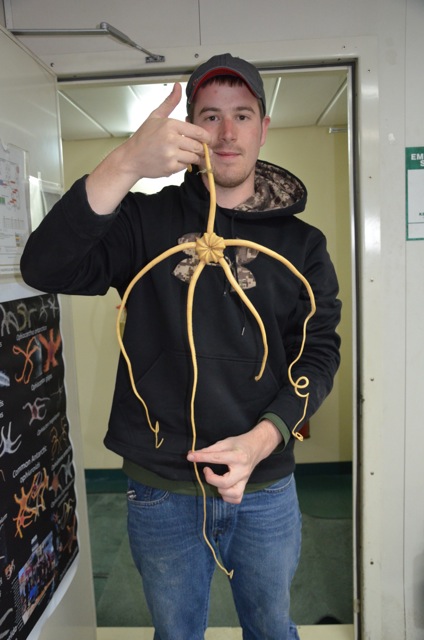
06 Dec 2013 - Bransfield Strait (62o 45.6`S 56o 51.6`W)
Today’s blog topic, also the focus of my research, will be on a class of echinoderm known as ophiuroids or brittle stars. Ophiuroids have incredible species richness in the Southern Ocean and in many sampling sites they comprise the majority of benthic biomass. Like other echinoderms, endoskeletons of ophiuroids are primarily composed of calcareous ossicles. These ossicles are not only critical in the formation of plates and shields in the central disc but also form one of the most recognizable characteristics of ophiuroids, the “vertebra” in the arms which gives ophiuroid arms a segmented appearance. Brittle stars have an amazing ability to cleave off the arm between two vertebrae allowing them to escape from a predator. Then they can re-grow the missing arm at a later date. While occurring in all the world’s oceans, most ophiuroid species are quite small but some in the Southern Ocean follow the trend of gigantism that has been recognized in so many other species of invertebrates down here. One such case is this specimen of Astrotoma agassizii (see above image) that we collected in the Weddell Sea, which is a member of the Gorgonocephalidae family and has the ability to move its arms in any direction, allowing A. agassizii to suspension feed.
One of the larger jobs we have on this sampling expedition regardless of the taxon of interest is to correctly identify and process the trawls. Many species of ophiuroids have cryptic morphological differences that make this a difficult task. This is further complicated when a single sampling site has a high species richness with a large biomass, but this is a welcomed complication and every researcher here is ecstatic when a trawl comes up primarily comprised of several species of their research interest. Pictured below is CO-PI Dr. Andrew Mahon from Central Michigan University holding a giant ball of ophiuroids from various families that needs to be sorted.
Many species of ophiuroids in the Southern Ocean are thought to be endemic and possess a circumpolar distribution. I am interested in using these ophiuroids as a phylogeographic tool to identify any open ocean barriers to dispersal and unrecognized diversity or cryptic speciation that may be occurring. While we are only half way through the sampling portion of this trip, so far it has been an overwhelming success for several of us, including myself. The samples we have collected so far have greatly increased my data size and geographic dispersal, which will be crucial to my dissertation. When the samples arrive back at Auburn University, we will be able to answer the phylogeographic questions I have raised through the use of polymorphic genetic markers, that we will use to identify patterns of gene flow between populations.
Contributed by: Matt Galaska, Ph.D. Student, Auburn University
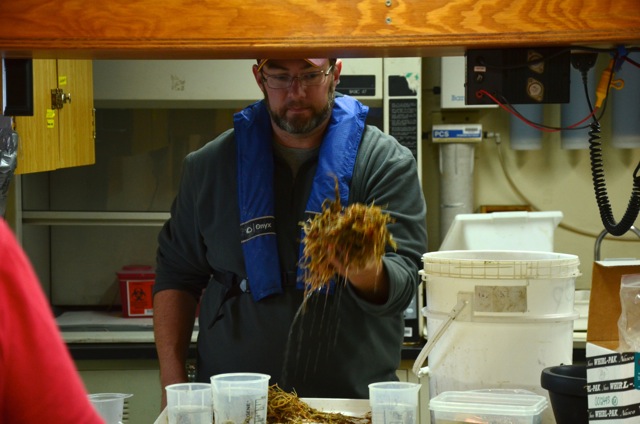
***************************************************************************************
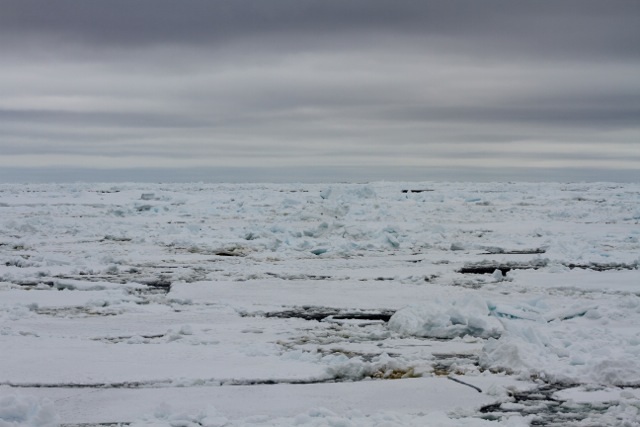
05 Dec 2103 - North of the Weddell Sea (62o 43`S 53o 38`W)
It is the eighth day of sampling, and we are currently in transit. We have had to tightly secure the lab, and the passage is slow going, because we are carefully avoiding huge packs of multiyear ice and pushing our way through copious amounts of slush (see above image). This ship does not have near the ice breaking capabilities of the R/V Nathanial B. Palmer, and every once and awhile the whole ship shivers and tilts as we hit a particularly large ice floe. These moments can be temporarily startling, but we always push through. Right now, we are sailing from the Weddell Sea back to the Drake Passage in order to sample near Elephant Island.
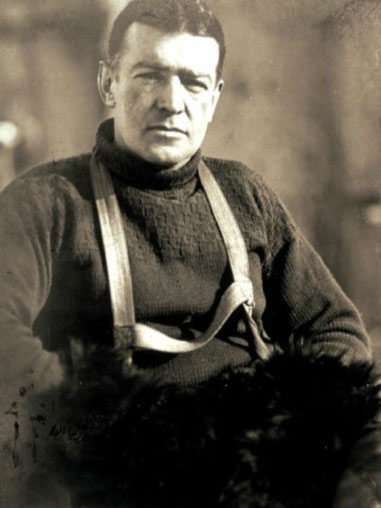
When I heard where we were going, I had the startling revelation that we are currently tracing the wake of another group of explorers, one which sailed a century ago. On the insistence of a friend, I am currently reading South: The Endurance Expedition, which is Ernest Shackleton’s (see above image) self-account of his famous voyage to Antarctica, from 1914 to 1917. Shackleton and his crew sought to be the first individuals to cross the entire Antarctic continent on foot. Despite all of their efforts, Shackleton’s men did not make it across the entire continent, and yet their voyage is still considered to be one of the most incredible in world history.
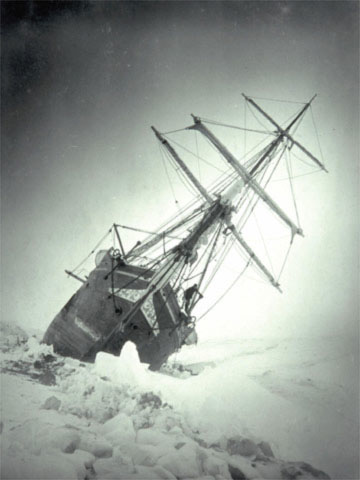
As they were sailing through the Weddell Sea in 1915, just as we are now, their wooden ship was surrounded by ice (see above image), and after almost a year of entrapment, it was crushed to splinters, capsizing the ship and forcing Shackleton and his twenty-seven crew members to eke out an existence on the ocean ice for almost half a year. They lived off of whale blubber, seal meat, and anything else they could scrounge. When even their drifting home began to melt and break apart beneath them, they finally decided to risk taking the few surviving life boats into the open ocean, searching for salvation. Finally they found a barren icy beach: Elephant Island. Shackleton and his men were the first to discover Elephant Island, and with no means of communicating with the outside world, Shackleton probably knew that they would never be rescued if they stayed there. So, Shackleton and five of his crew tried to make for South Georgia 800 miles away in order to get help, leaving the other twenty-two men behind on Elephant Island. Incredibly, every single one of Shackleton’s men survived this harrowing experience, and four months after Shackleton set out for help (which took a toll on him; see below image), they were finally rescued by Chileans.
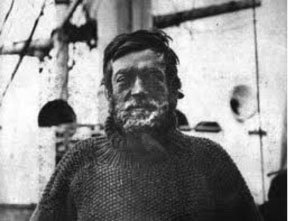
It is a little eerie to think that almost precisely one hundred years ago, Shackleton and his men were where we are now, struggling to survive. Every time we hit the ice harder than usual, my heart quickens its pace. But I am not truly worried. We have resources today that they never had, as well as a means for calling for help should we ever need it. After all, they did not have a metal ship, a GPS, or showers, or cell phones, or internet, or gasoline powered engines, or the ability to preserve food the way that we have now. They just had a wooden ship, a coal-powered engine, sailcloth, and a determined crew. Although I do not know that our crew would fare as well as Shackleton’s without our current technology, I do feel that we are equally determined in our purpose to explore and discover. It is the discovery that makes the hard work and long hours worth it. And with every new organism found, I like to think that we too leave a small mark on the history of the world.
Until next time.
Contributed by: Abigail Hollingsworth, Undergraduate Student, Central Michigan University
Source:
Shackleton, Ernest. South: The Endurance Expedition. April 1999: Signet, New American Library: New York; first published 1919 by William Heinemann: London.
***************************************************************************************
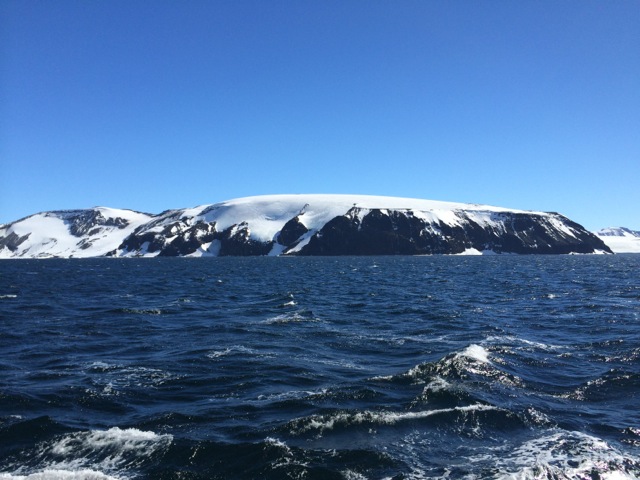
04 Dec 2013 – In the Northwestern Weddell Sea
We’ve been working and processing samples now for over a week and lots of things are happening at all hours of the day. One of the hardest things to deal with down here is the time. Our group is working on what we call “24 hour ops (operations)”, meaning at any hour of the day, we have a group working. My work hours are 12am (midnight) to noon, meaning a complete shift of normal working time for me. Not the easiest thing to adjust to, but we do it, and honestly, I prefer working this shift because we get to see the best scenery (see above image) and sunsets/sunrises when we’re out working on the deck. Since its light out nearly 24/7 the adjustment really wasn’t THAT hard.
After my shift yesterday, I decided that since it had been a week without doing so, I went to the ship’s workout room and went for a run on the treadmill. That has to be one of the most enlightening events of the trip for me. As I was running, I could see out the porthole and in view were mountains, icebergs, seals, and penguins. This place is special. I then started reflecting on how every time I’m here, new things come out of the trip.
In particular, among the neatest new things we’ve found are a number of new species. In particular are at least two new species of Antarctic leeches (see below image). Yes, leeches. The blood-sucking animals you know best from swamps, movies like “Stand By Me” and “The Life Aquatic with Steve Zissou”, etc. Last year when we were here, we collected a number of sea spiders with leeches on them, and interesting as they are, they were a species already described in the scientific literature. Thus, to our surprise and amazement, we were sorting through a trawl yesterday and found not one, but two new species of leeches, we were pleasantly surprised. One of them, seen in the picture here, was huge, somewhere around 8-10 inches long. It was gorgeous.
More importantly, when we return to CMU and Auburn, we’ll be able to analyze both morphology and genetics of these species to verify they are new to science and determine who they are related to new species. If the are new, we get the honor of naming and describing them, which is one of the most important parts of doing what we do….helping describe the untold amounts of biodiversity in this amazing part of the world.
More soon.
Contributed by: Dr. Andrew Mahon, Co-Principle Investigator, Central Michigan University
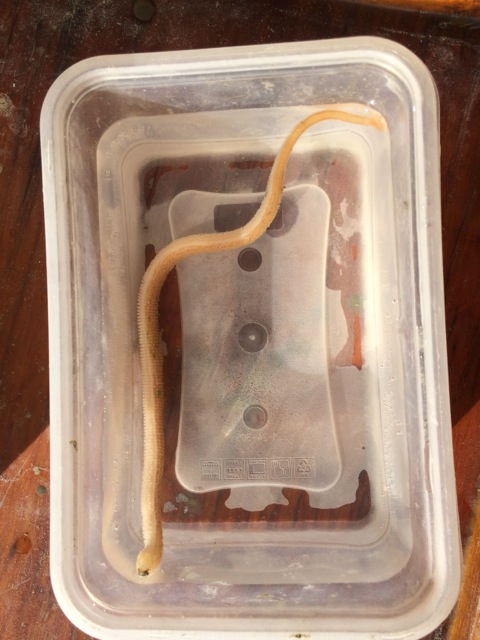
Last updated: 12/08/2013
